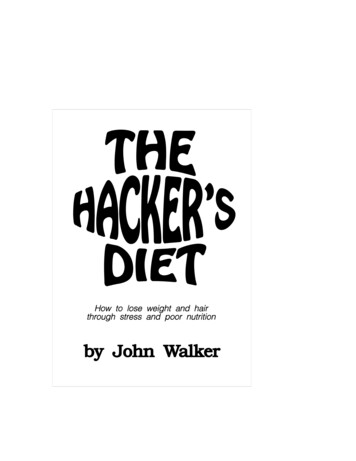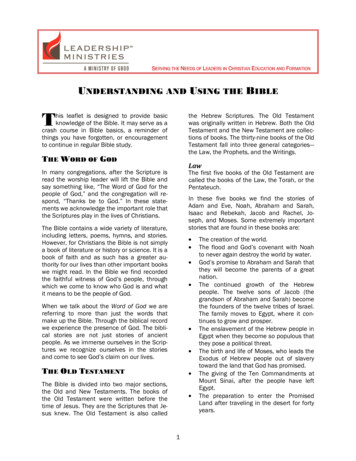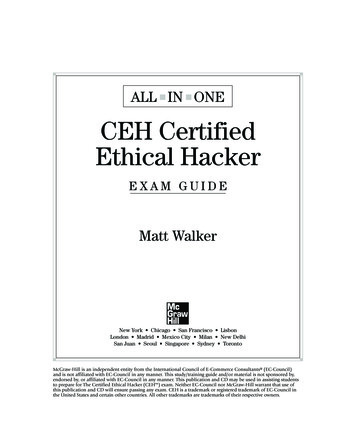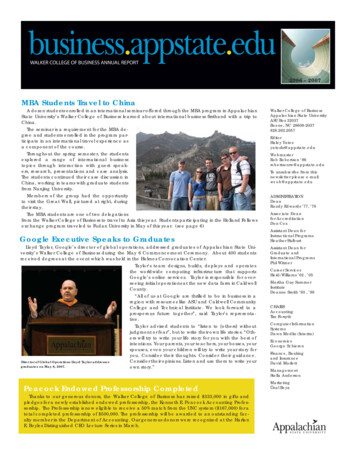
Transcription
by John Walker
The Hacker’s DietHow to lose weight and hairthrough stress and poor nutritionJOHN WALKER
Also by John WalkerTHE AUTODESK FILEc Copyright 1991–1993, John WalkerAll Rights ReservedNo part of this book may be used or reproduced inany manner whatsoever without written permissionexcept in the case of brief quotations embodied incritical articles and reviews.SECOND (ELECTRONIC) EDITIONThis book was published in December of 1993.Typeset with LATEX.TrademarksThe following trademarks are registered in the U.S.Patent and Trademark Office by Autodesk, Inc.: AutoCAD, Autodesk, AutoSketch, and AutoShade. Thefollowing are trademarks of Autodesk, Inc.: AutodeskCyberspace and Cellular Automata Lab. The following are trademarks of John Walker: The Hacker’sDiet and Eat Watch.Third-Party TrademarksAll brand and product names are trademarks orregistered trademarks of their respective companies.
CONTENTSPREFACE19INTRODUCTIONAbout losing weightAbout this bookAbout youAbout meAbout the computer toolsAbout pounds and inchesAbout time!1111121314161718I Engineering192212324262832THE EAT WATCHFood and feedbackMotivation and manipulationProgrammer, hack thyselfProblems: managing, fixing, and solvingWhat, me exercise?2
CONTENTS33THE RUBBER BAGWhat goes inWhat you burnWhat comes outInside the rubber bagSeizing controlInput/OutputFood fadsSummary3435363939415356604FOOD AND FEEDBACKMeasure the quantityDetermine the goalApply negative feedbackAvoid positive feedbackBang-bang vs. proportional controlThree possible outcomesThree different peopleFun with feedback6262636569737676875SIGNAL AND NOISEWired scienceCause and effectDexter’s dietMoving averagesThe truth in the trendClosing the circleExploring moving averages919295961031141241266WHAT, ME EXERCISE?Living longerFeeling betterThe fitness ladderClimbing the ladder131132134135136
4THE HACKER’S DIETIntroductory ladderLifetime ladderHow much is enough?Progress and motivationDetails137140145146151II Management1567WEIGHT MONITORINGGetting startedEvery dayEvery monthEvery year1581581611651748PLANNING MEALSWhy plan meals?Calorie targetsHow many meals, and when?A regular scheduleChoose the chowEat watch in actionSummary1761771781791811821922049LOSING WEIGHTClosing the loopGetting readyThe initial plungeThe long haulLate night, hungry, and aloneSuccess and stability206206212219228239249
CONTENTS510 PERFECT WEIGHT FOREVERRegaining: the problem and the causeCauses for confidenceFeedback foreverProportional feedbagEvading evangelismThe dream256257258260275277278III Details28011 PENCIL AND PAPERCalculating daily trendCalculating weight loss rateCalculating calorie deficitMaking weight chartsForecasting weight lossForecasting life extensionCalculating feedback modelsCalculating moving averages28228228428528528628728929012 UNITS AND CONVERSION FACTORSUnits of Volume (Fluid Measure)Units of Energy (Food value)Units of LengthUnits of Weight (Avoirdupois)Units of Dry VolumeAbbreviationsThe Weight of Water29629629729829829829930013 CALORIES IN VARIOUS FOODS301ABOUT THE AUTHOR332
6INDEXTHE HACKER’S DIET333
LIST OF TABLESDaily calorie requirements, menDaily calorie requirements, women3637Calories consumed by exerciseExercise ladder, introductoryExercise ladder, lifetime131138141Weight log sheet, blank162Weight goals, typical menWeight goals, typical women254255Units of fluid volumeUnits of energyUnits of lengthUnits of weightUnits of dry volumeAbbreviationsWeight of water296297298298298299300Calorie content of foods3017
8THE HACKER’S DIET
PREFACEThis is not a normal diet book, and I am not a normaldiet book author.I’m not a doctor. Nor am I a nutritionist, psychologist, sports hero, gourmet chef, or any of the othervocations that seem to qualify people to tell you how tolose weight.I’m an engineer by training, a computer programmerby avocation, and an businessman through lack of alternatives. From grade school in the 1950’s until 1988 Iwas fat—anywhere from 30 to 80 pounds overweight.This is a diet book by somebody who spent most of hislife fat.The absurdity of my situation finally struck home in1987. “Look,” I said to myself, “you founded one ofthe five biggest software companies in the world, Autodesk. You wrote large pieces of AutoCAD, the worldstandard for computer aided design. You’ve made inexcess of fifty million dollars without dropping dead,going crazy, or winding up in jail. You’ve succeeded atsome pretty difficult things, and you can’t control yourflippin’ weight?”Through all the years of struggling with my weight,the fad diets, the tedious and depressing history most9
10THE HACKER’S DIETfat people share, I had never, even once, approachedcontrolling my weight the way I’d work on any otherproblem: a malfunctioning circuit, a buggy program, anineffective department in my company.As an engineer, I was trained to solve problems. As asoftware developer, I designed tools to help others solvetheir problems. As a businessman I survived and succeeded by managing problems. And yet, all that time, Ihadn’t looked at my own health as something to be investigated, managed, and eventually solved in the sameway. I decided to do just that.This book is a compilation of what I learned. Sixmonths after I decided being fat was a problem to besolved, not a burden to be endured, I was no longeroverweight. Since then, my weight hasn’t varied bymore than a few pounds. I’m hungry less often at 145pounds than I was at 215. I look better, feel great, andhave more energy for the things I enjoy. I spend onlya few minutes a day maintaining this happy situation.And I know I’ll be able to control my weight from nowon, because I have the tools I need, the will to use them,and the experience to know they work.The tools are now in your hands.Live long and prosper.John WalkerSausalito, CaliforniaJanuary, 1991
1INTRODUCTIONAbout losing weightThere’s an old Wall Street tale: a tyro asks an oldtimer, “How do you make money in the market.” Thewise man answers, “Nothing could be simpler: buy low,sell high.” The beginner asks, “How can I learn todo that?” The sage responds, “Ahhhh. . . that takes alifetime.” Simple doesn’t mean easy.There is no magic secret to losing weight and keeping it off, just as there is no hidden key to instantwealth. Nonetheless, every year another crop of “magicdiet” and “secrets of investing” books appear on alreadycreaking shelves. The human capacity to ignore inconvenient facts and avoid unpleasantness is immense. Success in any endeavour requires coming to terms with thetrue nature of the task at hand and, if the goal is worththe effort, getting on with it.“How can I lose weight?” “Simple, eat less food thanyour body burns.” “How can I learn to do that?” Readthis book.11
12THE HACKER’S DIETAbout this bookThis book is about. . .How to. . . It’s a how-to book, but not a cookbook.Everybody’s different, and no one diet is right for all.This book will help you find a diet plan that works foryou. . . lose weight. . . Lose weight rapidly, and keep it offpermanently. Losing weight isn’t pleasant, and it’s farbetter to get it over with quickly, and never have to doit again. . . and hair. . . Just kidding. Actually, it seems to methe life of a middle aged male is a race between hairfalling out of its own accord and getting ripped out overstress and irritation. Women have it harder—they haveto rip it all out. . . through stress. . . Stress is an unavoidable consequence of living in our fast-paced, high-tech culture,yet few of us are willing to sacrifice its stimulation andexcitement to recapture the placid and serene life of simpler times. Stress is a primary cause of overeating andweight gain. You’ll learn how to break the cycle ofstress-induced eating and how to actually turn stress intoan ally in achieving your ideal weight. . . and poor nutrition. There is one, simple, unavoidable fact of dieting. To lose weight you have to eat lessfood than your body needs. Only by doing so can youcause your body to burn its reserves of fat and therebyshed excess weight. If nutrition is about meeting yourbody’s needs, losing weight involves deliberately shortchanging those needs—in a word, starving. This isn’ta pleasant or inherently healthy process, but it’s better than carrying around all that extra weight. You’llsee how to reduce your food intake intelligently, so you
INTRODUCTION13don’t end up with scurvy or something else unpleasantor embarrassing.About youThis book is written for successful, intelligent, and motivated people who happen to be overweight. Whetheryou’ve always been overweight, have been on a rollercoaster of dieting and regaining, or have just recentlyadded some excess poundage, the key resources youneed to achieve and maintain whatever weight and healthgoals you set for yourself are the same as you need toaccomplish anything else worthwhile in life:An eye firmly fixed on the goal.Will power.A high tolerance for pain.I don’t mean this to be facetious; vaulting any of life’shurdles, whether success in school, business, sports, thearts, or personal relationships requires the will and thewillingness to do what’s necessary, recognising that theachievement will more than repay the investment of timeand energy you make.This is the very key to success in anything—to beable defer immediate gratification in pursuit of a morepermanent and worthwhile future goal.This is precisely what losing weight involves. If you’resuccessful in the things that matter to you but overweight, all you need to lose that weight is to make accomplishing your weight and health goals matter just asmuch, then approach weight loss and control just likeany other important project: by developing and carrying
14THE HACKER’S DIETout a rational plan for success based on an understandingof what’s involved in achieving it.This book isn’t written for people who are or wish tobecome obsessed with their health. I consider weightcontrol and fitness like any other aspect of life that’simportant enough to do, but hardly my reason for being. It’s like balancing the checkbook, going groceryshopping, or getting the car tuned up. The goal is to getthe job done, and done right, as quickly as possible andwith the minimum effort.About meI’ve been overweight most of my life.In 1987, not yet forty years old, I achieved the materialgoals I’d been working for all my life. The companyI founded, Autodesk, Inc., had achieved a commanding position in its industry, enriching me beyond thebounds of even my perfervid imagination. I’d handedthe management over to willing and capable people andreturned full-time to the work I love most, programmingand writing. I’d moved to a beautiful house on a cliffoverlooking the Pacific Ocean, shared with my intelligent, resourceful, and attractive wife.What’s wrong with this picture? Well, I was fat as ahawg and in lousy shape. I hadn’t exercised since highschool. I’d lost some weight once in the mid 1970s, butput it all back on in less than a year.Life has a way of evening things out. And, I figured,dropping dead before forty would balance out a greatdeal of the success I’d clawed from the flinty soil oflife. What a drag.So, there was nothing for it but to shed all those
INTRODUCTION15pounds I’d packed on through the stressful years of starting, growing, and running a company. “If all you haveis a hammer, everything looks like a nail.” I’m an engineer. I decided to approach weight loss as an engineering problem.I studied the human body the way I’d tackle a misbehaving electronic circuit or computer program: developa model of how it works, identify the controls that affectit, and finally adjust those controls to set things aright.It worked. In less than a year, totally under my owndirection and without any drugs or gimmicks, I wentfrom 215 pounds to 145 and achieved physical fitness.Since then, I’ve kept my weight right where I want itwith none of the yoyo swings I’d suffered in the past.All of this was accomplished in less than 15 minutes aday, and without any significant changes in the way Ichoose to live my life.What’s more, I came to understand the game of weightcontrol. Confidence, founded in understanding and confirmed by success, makes maintaining an ideal weightfar more likely. What I discovered was so simple, soobvious, yet so profound and useful I decided to makethe tools that worked for me available to everybody. SoI wrote this book.I lost weight recently enough to remember clearly whatdieting involves but long enough ago to be confident Ihave a way to avoid gaining it back. I understand whatyou’ve gone through trying to lose weight previously. Iknow what lies ahead. I’ve been there. It’s worth it.
16THE HACKER’S DIETAbout the computer toolsI’m a computer freak, so the first thing I did whenI started thinking about losing weight was develop abunch of computer-based tools to help me understand,monitor, and control the process. Collecting the data,analysing it with a computer, then applying the insights Igained taught me more about losing and gaining weight,and how the body works in general than a lifetime offailed diets and a truckload of diet books. This book notonly explains what I’ve learned, it describes how to usethe tools to understand how your own body works.The tools are all spreadsheets based on Microsoft Excel. Please refer to the README.DOC file which accompanies the tools for information about the hardwareand software they require. In addition to the spreadsheets that let you plan, track, and chart your weightloss, many of the tables in this book are also supplied asExcel files so you can experiment with them and incorporate them into other health management tools. Eachtable in the text supplied in Excel form specifies the filename in computer type (for example, “WEIGHT.XLS”)at the top of the table.You don’t need a computer to lose weight. Everytechnique in this book can be applied just as effectivelywith pencil and paper, in little additional time. The computer tools produce spiffier looking graphs, allow you toplay around with the data in amusing ways, and let youexperiment with “what-if” calculations without pencilpushing. If you have a computer, you’ll appreciate theconvenience it affords, but it won’t determine whetheryou succeed or fail in losing weight.Chapter 11 provides “Pencil and paper” methods equivalent to each computer-based calculation. In addition to
INTRODUCTION17making the techniques accessible to those without propercomputers, these sections also explain how the spreadsheets work and are worth reading if you’re interestedin modifying them.About pounds and inchesI usually use the metric system, but in this book I’vestuck to English units throughout. Even scientists whowork all day in metric units think of themselves as “fiveeleven, one-sixty.” Metric units would only confuseU.S. readers and make the essential techniques in thebook less accessible. I apologise to readers in more enlightened areas of the world. I’ve also conformed to thesomewhat sloppy practice in most nutrition books of using “calorie” to mean what is more precisely termed“kilogram calorie” or “kcal”—the energy required toraise the temperature of one kilogram of water one degree Celsius. The “gram calorie,” 1000 times smaller,is cumbersome when discussing the energy content offood. In Europe, food energy value is frequently givenin kilojoules (kJ), the metric unit of energy. To convertkilojoules to kilogram calories (“food calories”), divideby 4.184.The Excel spreadsheets allow you to specify whetherweight is measured in pounds, kilograms, or stones; eachspreadsheet which uses weight measurements contains acell near the top which specifies the unit of weight. If setto 1 (as supplied), weights are in pounds. If you changethe cell to 0, weights are in kilograms. If you set it to1, weights are measured in stones. Also included isUNITS.XLS, an Excel worksheet providing conversionfactors among all the odd English units encountered in
18THE HACKER’S DIETconnection with food (teaspoons per cup, for example),plus their metric system equivalents.About time!Enough tedious preliminaries—let’s get on with it! Thesooner you start, the sooner you can put the overweight,out of shape part of your life behind you.You’ve probably already decided you don’t want to beoverweight. Otherwise, why read a diet book? You’reabout to learn what’s involved in achieving your goal.Mastering and applying the tools for weight and healthmanagement in this book will allow you to succeed,probably within the next 12 months. By this time nextyear, then, having reduced a nagging lifelong problem toa few minutes a day of minor effort, you’ll look forwardto many additional healthy years replete with all the joyslife has to offer.
Part IEngineering19
2THE EAT WATCHMy hunger serves me instead of a clock.—Jonathan Swift, Polite Conversation,1738Wouldn’t it be great if you could visit your local purveyor of electronic marvels and purchase one of these?Marinchip Eat WatchWeight Turbo Digital21
22THE HACKER’S DIETYou strap it on your wrist, set it for the weight youwant to be, then rely on it to tell you when to eat andwhen to stop. Whenever it says EAT, just chow downon anything you like until EAT goes out. Obviously theEAT indicator will stay on longer if you’re munchin’cabbage instead of chugging München’s finest beer.As long as you heeded the Eat Watch, you’d attainand maintain whatever weight you set it to. If you atethe wrong foods or had your meals on an odd scheduleyou might be hungry, but you’d never be fat. And, withthe eat watch guiding you, you’d rapidly find a mealschedule and makeup that banished hunger forever.The eat watch wouldn’t control you any more than aregular watch makes you get to work on time. You canignore either, if you wish. You decide, based on theinformation from the watch, what to do.Some people are born with a natural, built-in eat watch.You and I either don’t have one, or else it’s busted. Butinstead of moping about bemoaning our limitations, whynot get an eat watch and be done with it?You can’t buy an eat watch in the store, at least notyet. But you can make one that works every bit as well.It isn’t a gadget you wear on your wrist; it’s a simpletechnique you can work with pencil and paper or with apersonal computer. It tells you same thing: when to eatand when to stop eating. The eat watch you’ll discoverin this book is simple to work, easy to use, and highlyeffective in permanently controlling your weight.The next few chapters lay the background for building an eat watch. The principles on which the eat watchis based are subtle and, although they’ve been used inengineering for decades, seldom are mentioned in conjunction with weight control. I’ll explain them in detail.
THE EAT WATCH23The road to understanding the eat watch is a long butinteresting one. When we reach its end, you’ll not onlyknow how to use an eat watch, but how and why itworks. Then you’ll have the confidence, founded onknowledge, that your weight is totally and permanentlyunder your control.Food and feedbackIf people didn’t eat except when their bodies neededfood, nobody would be overweight. What a wonderfulworld it would be! (Of course, there wouldn’t be amarket for diet books. . . .)Hunger is supposed to tell us when it’s time to eat, butin the modern world, we rarely rely on this message fromour bodies. We eat certain meals on a given schedule,with family and friends. And, while hunger tells uswhen to eat, there isn’t a corresponding signal that sayswe’ve had enough. Only when the scale begins to rackup extra pounds and the belt seems to need another notchdo we realise the cumulative effect of a little too muchfood every day.As long as you aren’t hungry, you’re probably getting enough food, but how do you keep from eating toomuch? What’s needed, along with food, is feedback—information that tells how you’re doing—when to eatand when to stop: the message of the eat watch.I believe one of the main reasons some people havetrouble controlling their weight while others manage iteffortlessly is that there’s a broken feedback circuit inthose of us who tend to overweight. Our bodies don’ttell us “enough already!”, while our slim and trim comrades, born with a built-in eat watch, always know when
24THE HACKER’S DIETto hang up the nosebag.But, hey—no problem! Back when we were all huntergatherers, people with crummy eyesight probably didn’tlive very long. It’s hard to throw a spear when you can’teven see the end of your arm. Along comes technologyand zap!!!: eyeglasses fixed that problem once and forall. Actually, it’s tilted the other way these days; if Iweren’t blind as a cinder block without my glasses, I’dprobably have been sent to ’Nam.So it is with the eat watch. If you weren’t born withone, just get one, strap it on your wrist, and get on withlife.Motivation and manipulationControlling your weight provides an interesting windowon the enigma of sentience, the distinction between mindand body. Weight control involves the body at the simplest level; eat more and gain weight, eat less and loseit. Yet the reasons we become overweight and the difficulties we have in losing weight often stem from thesubtleties of psychology rather than the mechanics ofmitochondria.To control your weight, you need only eat the rightamount. To eat the right amount, not just this month ornext month, but for the rest of your life, you need notonly the information—the display on the face of the eatwatch—to know what’s the “right amount”; you needan incentive to follow that guidance. Wearing a watchdoesn’t make you a punctual person, but it provides theinformation you need to be one, if that’s your wish.This incentive is the “motivation to control your weight,”often simplistically deemed “will power.” Where can
THE EAT WATCH25you find this motivation, especially if you’ve tried dietafter diet and failed time after time? This book willhelp you to find the motivation in the only place it canbe found, within yourself, by laying out a program thatmakes the steps to success easy and the thought of failure or backsliding difficult to contemplate.This constitutes manipulation, but manipulation’s OKas long as you’re manipulating yourself. After all, inorder to manipulate somebody you have to understandthem, and who do you understand better than yourself?The goal is empowerment: the sudden realisation, “Hey,this isn’t hard at all! I can do this!” It is such discoveriesthat give us the confidence and courage to go onward togreater challenges. The course of a life is often chartedby such milestones of empowerment. Manipulation inthe pursuit of empowerment is no vice.Latent within you is the power to control your weightfor the rest of your life. All you need to do is realisethat your weight is under your conscious control. Withthat knowledge, you can peel off your excess weightand achieve physical fitness. Once you’ve accomplishedthose goals, you’ll be in a position to make them centralto your self-image.Less than 12 months from now, new people you meetwill be incapable of imagining you as overweight. Nextyear, you’ll be able to run up four flights of stairs andscarcely notice the exertion. If, like me, you’ve beenoverweight most of your life, you’re about to partakeof a new and rich part of the human experience: theexultation of living in a healthy animal body.Once you’ve experienced the joy, the confidence, andthe feeling of power that success entails, you’ll neverconsider giving it up—not even for that extra slice of
26THE HACKER’S DIETpie.Programmer, hack thyselfRecently, the word “hacker” has fallen into disrepute,coming to signify in the popular media the perpetrators of various forms of computer-aided crime. Butmost of the people who call themselves hackers, whohave proudly borne that title since the 1950’s, are notcriminals—in fact many are among the intellectual andentrepreneurial elite of their generations.The word “hacker” and the culture it connotes is toorich to sacrifice on the altar of the evening news. BobBickford, computer and video guru, defined the trueessence of the hacker as “Any person who derives joyfrom discovering ways to circumvent limitations.”Indeed. . . . Well, what better limitations to circumventthan ones you’ve endured all your life? For the lastfew years, I’ve spent a weekend every Fall attendingthe “Hackers Conference”: a gathering of computer folkwho exult in seeing limitations transcended through creativity. A commemorative T shirt is designed for eachconference, so when you fill out your application, youhave to say what size you wear. Hackers being hackers,it’s inevitable that somebody will enter these data intoa computer and analyse them.The statistics are remarkable. We’re talking megayards here; one wonders what the numbers would beif T-shirts came in Extra-Extra-Large, Jumbo, Gigantic,Colossal, Planetary, and Incipient Gravitational Collapsesizes as well as the usual S, M, L, and XL.People who thrive on unscrewing the inscrutable—figuring out how complicated systems work and con-
THE EAT WATCH27trolling them—sometimes fail to apply those very techniques to maintaining their own health. How strange toon the one hand excel at your life’s work and on theother, XL in girth.But not that strange, really. I’ve been there. Fordecades I believed controlling my weight was impossible, too painful to contemplate, or incompatible with theway I chose to live my life. I’d convinced myself thatthe only people who were physically fit were lawyersand other parasitic dweebs who, not forced to earn anhonest living, had the time for hours of pumping variousodd machines or jogging in the middle of the road whilehard-working, decent folks were trying to get to work.Most extraordinary things are done by ordinary peoplewho never knew what they were attempting was “impossible.” Hackers have seen this happen again and again;many of the most significant innovations in computinghave been made by individuals or small groups, working alone, attempting tasks the mainstream consideredimpossible or not worth trying.Once you possess the power to circumvent limitations, to control things most people consider immutable,you’re liberated from the tyranny of events. You’re nolonger an observer; you’re in command. You’ve becomea hacker. This book is about one simple, humble thing:getting control of your weight and health. By circumventing the limitations that made you overweight in thefirst place and keep you that way, you’re hacking themost complicated and subtle system in the world: yourown human body. Weight control—what a hack! Onceyou realise you can hack your weight, who can imaginewhat you will turn to next?
28THE HACKER’S DIETProblems: managing, fixing, and solvingIn every era, each culture defines itself in terms of theheroes it admires. That, in turn, determines the mindset and aspirations of the generation whose values areformed during that time. For past generations explorers, military men, inventors, financiers, and statesmenhave filled the role of hero. I believe that our time isthe age of the manager. The MBA degree, a credentialthat qualifies one to administer by analysing and manipulating financial aggregates, has become the most prizedticket to advancement in the United States. The valuesmanagers regard most highly: competence, professionalism, punctuality, and communication skills have beenenshrined as the path to success and adopted by millions.The cult of management, for that is what it is, pervadesthe culture which is its host. In time, it will be seen tobe as naive as the ephemeral enthusiasms that precededand will, undoubtedly, supplant it in due course. Butnow, at the height of its hold, it’s important to distinguish managing a problem from fixing it, for these arevery different acts: one is a process, the other an event.Solving a problem often requires a bit of both.Managing problems“Management must manage” was the motto of HaroldGeneen, who built ITT from an obscure internationaltelephone company into the prototype of the multinational conglomerate. What Geneen meant by this is thatthe art of the manager is coming to terms with whateversituations develop in the course of running a businessand choosing the course of action that makes the best ofeach.
THE EAT WATCH29The world of the manager is one of problems andopportunities. Problems are to be managed; one mustunderstand the nature of the problem, amass resourcesadequate to deal with it, and “work the problem” on anongoing basis. Opportunities are merely problems thatpromise to pay off after sufficient work.Managers are not schooled in radical change. Theelimination of entire industries and their replacementwith others, the obsolescence of established products inperiods measured in months, the consequences of continued exponential growth in technology are all foreignto the manager. Presented with a problem, an expertmanager can quickly grasp its essence and begin to formulate a plan to manage the problem on an ongoingbasis.But what if the problem can be fixed? This is not thedomain of the manager.Fixing problemsEngineers, derided as “nerds” and “techies” in the age ofmanagement, are taught not to manage problems but tofix them. Faced with a problem, an engineer strives todetermine its cause and find ways to make the problemgo away, once and for all.An engineer believes most problems have solutions.A solution might not be achievable in the short term,but he’s sure somewhere, somehow, inside every problem there lurks a solution. The engineer isn’t interestedin building an organisation to cope with the problem.Instead, the engineer studies the problem in the hope offinding its root cause. Once that’s known, a remedy maybecome apparent which eliminate
10 PERFECT WEIGHT FOREVER 256 Regaining: the problem and the cause 257 Causes for confidence 258 Feedback forever 260 Proportional feedbag 275 Evading evangelism 277 The dream 278 III Details 280 11 PENCIL AND PAPER 282 Calculating daily trend 282 Calculating weight loss rate 284 Calculating cal










